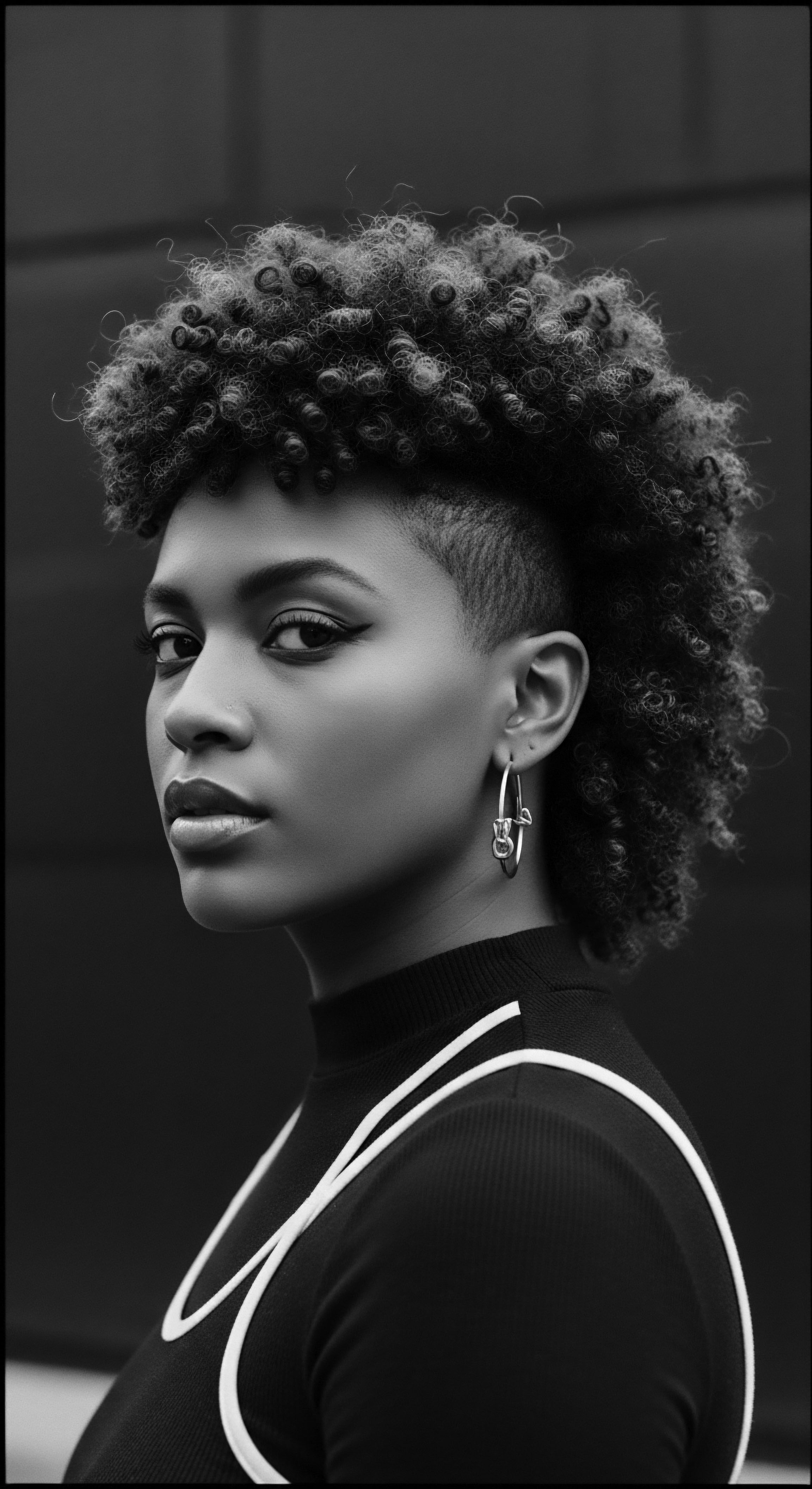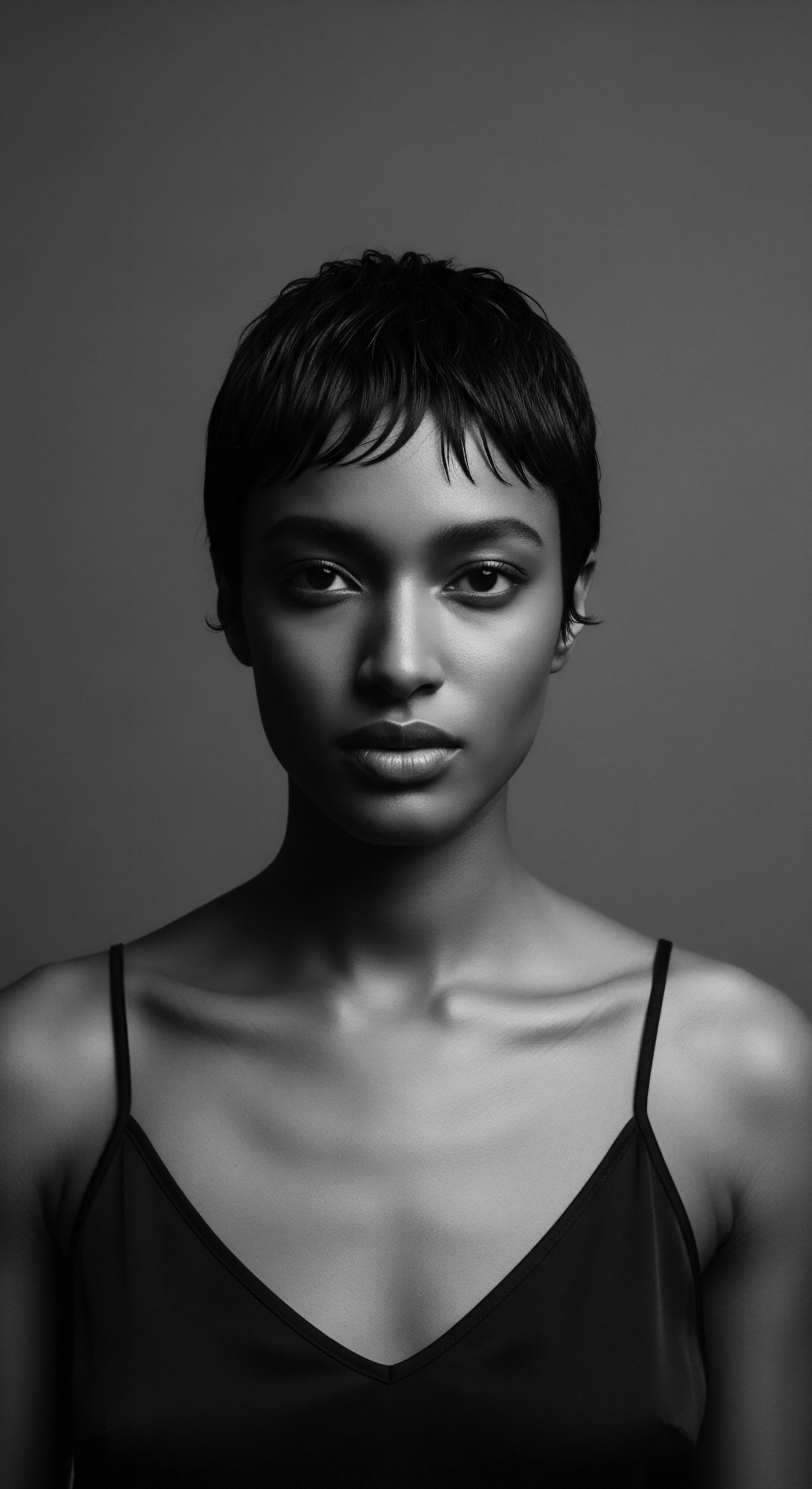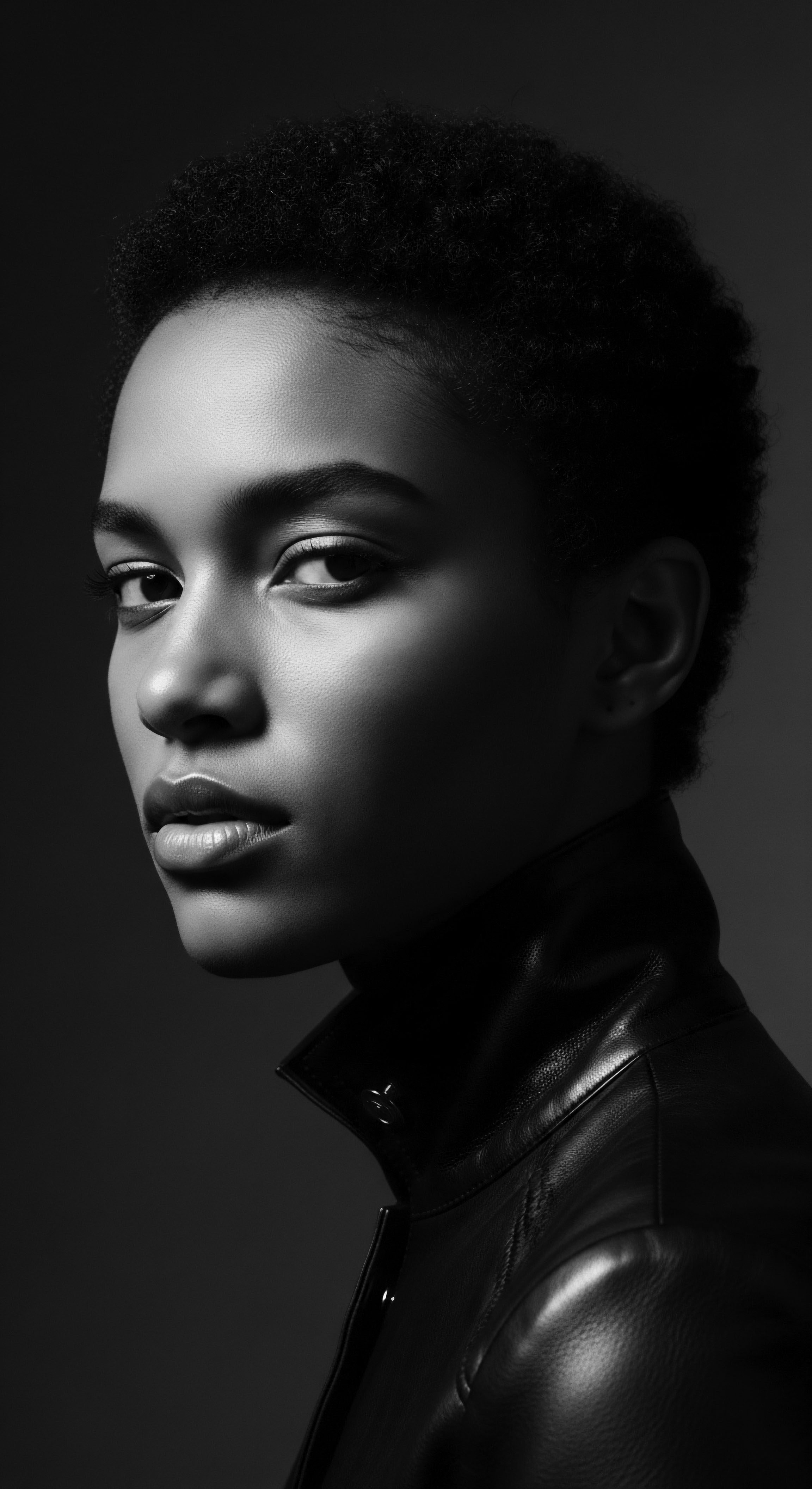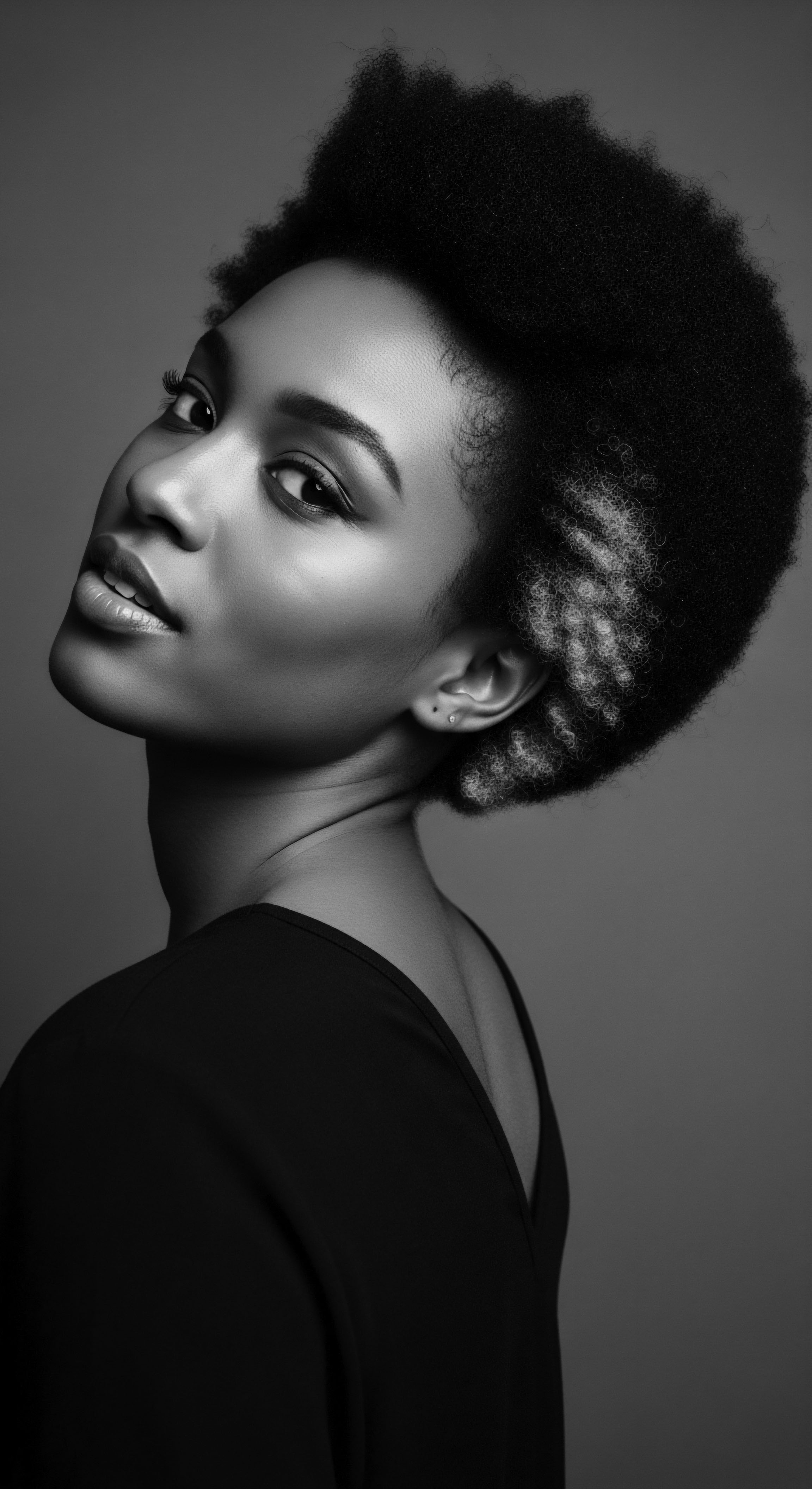
Roots
There exists a profound dialogue between the strands of textured hair and the ancient earth from which our traditions spring. This conversation echoes through generations, a whispers of ancestral knowledge carried on the wind, affirming that true care often finds its genesis in simplicity, in the gifts of the land. For countless individuals with textured hair, particularly those whose lineage traces back to African soil, this dialogue finds a resonant voice in the unassuming richness of shea butter.
It is not merely an ingredient in a jar; it stands as a venerable symbol of resilience, a testament to the enduring wisdom of those who came before us. Its presence within our hair care rituals speaks to an intuitive understanding of the hair strand’s needs, an understanding honed over millennia and now, remarkably, validated by the very instruments of modern scientific inquiry.

Anatomy and Ancestral Understanding of Textured Hair
The intricate architecture of textured hair—its unique curl patterns, its elliptical follicle shape, the inherent twists and turns along each strand—presents a distinct set of requirements for optimal health and vitality. Unlike straighter hair types, coiled and kinky strands possess more cuticle layers that tend to lift, allowing moisture to escape readily. This structural reality makes textured hair inherently prone to dryness and breakage, a vulnerability keenly observed and addressed by ancestral practices long before dermatological textbooks codified such observations. The wisdom of our foremothers and forefathers recognized this delicate balance, devising methods of protection and nourishment that leaned heavily on the readily available natural resources of their environment.
Traditional shea butter practices offer a timeless framework for textured hair care, their efficacy now affirmed by contemporary scientific understanding of hair’s unique biology.
Among these resources, the fruit of the Vitellaria Paradoxa tree, the shea tree, held a place of honor. From Senegal to Uganda, across the “Shea Belt” of West and Central Africa, this tree, often called the “tree of life,” yielded its precious nuts, from which women traditionally extracted the golden, creamy butter. This butter, known by various names such as Nkuto in Ghana or Òri in Yoruba culture, became a cornerstone of beauty and wellness rituals, a versatile balm applied to skin and hair alike.

The Essential Lexicon of Textured Hair from a Heritage Perspective
To truly grasp the alignment between traditional shea butter practices and modern hair science, we first honor the language that describes our hair and its care through time. The descriptive terms for textured hair types often reflect an external, visual classification, yet the underlying biology speaks to shared vulnerabilities and strengths. Ancestral lexicons, passed through oral tradition, likely focused on perceived qualities and needs ❉ hair that thirsts for moisture, hair that thrives under gentle manipulation, hair that tells a story of lineage.
Modern science provides us with terms like ‘porosity,’ ‘cuticle integrity,’ and ‘elasticity,’ but these concepts merely articulate, in a different tongue, the very phenomena our ancestors intuitively understood. They knew, through observation and inherited wisdom, what kept the hair supple, vibrant, and protected under the unforgiving sun.
Shea butter, within these ancient frameworks, served a multitude of roles, from a protective barrier against harsh climates to a softening agent for coarse strands. Its historical use is documented as far back as the 14th century, with evidence suggesting its use for thousands of years in Africa for food, balms, soaps, and traditional medicines. Even earlier, gas chromatography-mass spectrometry of ancient Egyptian mummies from 2600-3500 years ago suggests the use of a stearic acid-rich material, potentially shea butter, on their hair.
- Vitellaria Paradoxa ❉ The scientific name for the shea tree, indigenous to the “Shea Belt” of Africa.
- Women’s Gold ❉ A cultural appellation for shea butter, acknowledging its economic importance, particularly for women in West African communities.
- Karite Tree ❉ Another name for the shea tree, signifying its healing properties and vital role.

Ritual
The journey of shea butter from tree to hair is steeped in ritual, a slow, intentional process that reflects a deep respect for the ingredient and its ancestral origins. These rituals, often carried out by women, are not simply steps in a recipe; they are acts of continuity, a passing down of knowledge, a communal embrace of heritage. This handcrafted process, involving harvesting, sun-drying, grinding, and laborious hand-kneading, transforms the raw nuts into a creamy, golden balm. Such methods, refined over centuries, intuitively prepared the butter to deliver its potent benefits to textured hair, anticipating the very needs modern hair science now dissects with precision.

The Intentional Application of Ancestral Balms
Traditional application of shea butter to hair was never a casual act. It was an intentional ritual, often involving warming the butter in the hands until it softened, then gently working it through strands and onto the scalp. This warming process, whether over a low flame or with body heat, intuitively prepares the butter for deeper penetration.
Modern science affirms that warming allows shea butter’s fatty acids to become more fluid, aiding their spread and absorption into the hair shaft and scalp. This practice helps to smooth the hair cuticle, thereby sealing in moisture and reducing the likelihood of breakage, a constant challenge for textured hair.
Consider the age-old practice of using shea butter to prepare hair for protective styles—braids, twists, and various forms of threading. Before the advent of modern styling creams, shea butter provided the necessary slip and pliability, allowing for easier manipulation of dense, coily strands. This forethought ensured the hair remained moisturized and less prone to tension-induced damage during and after styling. The traditional application of a rich, occlusive butter before styling is a testament to an innate understanding of moisture retention, a practice validated by today’s emphasis on sealing agents for textured hair.

The Nighttime Sanctuary and Bonnet Wisdom
The care of textured hair extends beyond daylight hours, and ancestral wisdom recognized the profound importance of nighttime rituals. The practice of wrapping hair or covering it with soft cloths before sleep was not merely for aesthetic purposes; it was a crucial protective measure. Shea butter often played a role in these evening routines, applied to hair before it was styled for bed. This ritual served to protect delicate strands from friction against rough sleeping surfaces, preventing tangles, breakage, and moisture loss.
Ancestral hair care practices, particularly the skilled application of shea butter, laid foundations that modern science now explains through the lens of lipid barriers and cuticle health.
Modern hair science confirms the importance of minimizing mechanical stress on hair during sleep. Satin or silk bonnets and pillowcases are now widely recommended to reduce friction, maintaining hair’s moisture and structural integrity. This contemporary advice echoes the traditional foresight of protecting hair, ensuring that the moisture infused by shea butter during the day remained sealed within the strands overnight. The long-standing use of protective head coverings, whether elaborate wraps or simple cloths, alongside nourishing shea butter, illustrates a continuous, unbroken line of understanding concerning textured hair’s delicate nature.
| Traditional Practice with Shea Butter Warming butter before application |
| Modern Scientific Alignment Increases fluidity of fatty acids for better absorption and distribution. |
| Traditional Practice with Shea Butter Applying to damp hair |
| Modern Scientific Alignment Creates an occlusive barrier to seal in water molecules, preventing dehydration. |
| Traditional Practice with Shea Butter Using for protective styling |
| Modern Scientific Alignment Provides slip and reduces friction, minimizing mechanical stress and breakage. |
| Traditional Practice with Shea Butter Nighttime hair wrapping |
| Modern Scientific Alignment Reduces friction and moisture loss, preserving hair integrity during sleep. |
| Traditional Practice with Shea Butter Massaging into scalp |
| Modern Scientific Alignment Stimulates circulation and delivers anti-inflammatory compounds to soothe irritation. |
| Traditional Practice with Shea Butter These interwoven practices highlight a deep, enduring wisdom that bridges generations of textured hair care. |

Relay
The persistent legacy of traditional shea butter practices lies not just in their historical continuity but in their profound resonance with the discoveries of modern hair science. What our ancestors knew through generations of embodied experience, contemporary research now elucidates through molecular structures and dermatological studies. The wisdom passed down through hands stained golden with shea butter finds its echo in the laboratory, proving that ancient insights are often precursors to scientific revelation.

The Molecular Echoes of Ancestral Wisdom
Shea butter’s remarkable efficacy stems from its distinctive biochemical makeup. It is a complex mixture of fatty acids, notably Oleic Acid and Stearic Acid, which together constitute a significant portion—around 85 to 90 percent—of its fatty acid composition. Oleic acid, a monounsaturated fatty acid, allows shea butter to penetrate the hair shaft, delivering moisture deep within the cortex.
Stearic acid, a saturated fatty acid, creates a protective barrier on the hair’s surface, effectively sealing in that moisture and shielding the strands from environmental aggressors. This dual action of deep conditioning and external protection explains why shea butter has been a staple for textured hair, which naturally struggles with moisture retention due to its unique structural characteristics.
Beyond these primary fatty acids, shea butter also contains unsaponifiable components, a group of compounds that include triterpenes, phytosterols, and certain vitamins. These elements contribute significantly to shea butter’s therapeutic properties. For instance, the presence of Cinnamic Acid Esters provides a mild degree of natural UV protection, a benefit intuitively recognized by West African women who used shea butter to shield their hair and skin from the intense sun. This inherent sun-shielding property, though not a substitute for dedicated sunscreen, reflects an early, practical form of hair protection from environmental damage, aligning with modern photoprotection principles.

Validating the Healing Hand of Tradition
Modern scientific inquiry offers compelling validation for traditional shea butter uses, particularly concerning scalp health. Textured hair, with its propensity for dryness, often leads to a dry, irritated scalp, which can compromise hair growth and health. Research indicates that shea butter contains compounds like Amyrin and specific triterpene cinnamates and acetates, which possess well-documented anti-inflammatory properties. These compounds reduce redness and irritation, promoting a balanced scalp environment without clogging pores.
The scientific breakdown of shea butter’s components reveals a profound natural synergy that validates centuries of traditional usage for hair and scalp wellness.
A study published in the Journal of the American Academy of Dermatology on a cream containing 5 percent shea butter, though focused on skin, noted moisturizing effects lasting up to eight hours. This directly supports the traditional understanding of shea butter as a sustained emollient for both skin and hair. The traditional practice of massaging shea butter into the scalp thus delivers these beneficial anti-inflammatory and moisturizing agents directly to the hair follicles, fostering a healthier foundation for growth. This is not merely anecdotal; it is a convergence of ancient wisdom and contemporary biochemical understanding.
The practice of “sealing” moisture into textured hair, a common modern regimen, finds direct resonance in historical shea butter application. After washing and conditioning, applying a butter like shea locks in the water, which is the ultimate hydrator for hair. This creates a protective, hydrophobic layer.
As Cosmébio notes, cosmetic products aid in making hair hydrophobic, preventing damage, especially from water loss, and ingredients like plant butters create a barrier around the hair fiber. This mechanism perfectly explains the long-observed benefits of traditional shea butter use ❉ reduced breakage, enhanced softness, and improved manageability.
Consider the economic impact and heritage sustainability. The shea industry remains primarily women-led in West Africa, providing income for millions. This economic empowerment, woven into the very fabric of shea butter production, signifies a socio-cultural alignment with hair wellness—a holistic view where care for hair translates into community resilience and autonomy. The journey of shea butter from African hands to global vanity tables signifies not just a commodity, but a living tradition sustaining livelihoods and cultural identity.

Reflection
To contemplate the ways traditional shea butter practices align with modern hair science is to stand at a historical confluence, where the deep currents of ancestral wisdom meet the precise streams of contemporary understanding. This journey reveals more than mere correlations; it unveils a continuous narrative of care for textured hair, a narrative sculpted by generations of hands-on experience and now illuminated by the clarifying lens of scientific inquiry. The very strands of textured hair carry within them a biological memory, a predisposition for certain needs that our ancestors, through their profound connection to the land and its gifts, intuitively fulfilled with the golden essence of the shea tree.
The Soul of a Strand, then, is not an abstract concept; it is the living archive of this enduring heritage. It speaks of the grandmother who knew, without a chemist’s report, that shea butter would guard her grandchildren’s coils against the parching sun and the dry winds. It whispers of communal rituals where shea was warmed, massaged, and celebrated, not just as a cosmetic aid, but as a symbol of protection, purity, and sustenance. That modern trichology can now pinpoint the exact fatty acids, vitamins, and anti-inflammatory compounds responsible for these cherished benefits only deepens our reverence for that original, unwritten wisdom.
The scientific validations do not diminish the magic; they elevate it, allowing us to appreciate the genius inherent in traditional practices. This alignment calls us to recognize that true innovation often lies in rediscovering and respecting the profound knowledge embedded in our collective past, especially when it comes to the nuanced care of textured hair, a vibrant symbol of resilience and identity.

References
- Akihisa, T. et al. (2000). Triterpene alcohol and fatty acid composition of shea nuts. Journal of Oleo Science, 49(12), 1145-1151. (Used for scientific composition of shea butter compounds)
- Gallagher, M. E. et al. (2023). The Archaeology of Shea Butter. Journal of African Archaeology, 21(1), 1-22. (Used for historical evidence of shea butter in ancient mummies)
- Mank, V. et al. (2014). Skin moisturizing effects of a cream containing shea butter in a double-blind, randomized clinical trial. Journal of the American Academy of Dermatology, 70(5), AB134. (Used for moisturizing effects of shea butter)
- Verma, N. et al. (2012). Anti-inflammatory activity of Shea butter. International Journal of Chemical and Pharmaceutical Sciences, 3(1), 18-20. (Used for anti-inflammatory properties of shea butter)
- National Center for Complementary and Integrative Health. (2023). Shea Butter. (General information on shea butter composition and traditional uses)
- Agyemang, S. (2020). The Contribution of Shea Butter Production to Women’s Livelihoods in Northern Ghana. International Journal of Economics, Commerce and Management, 8(3), 56-69. (Used for economic empowerment of women)
